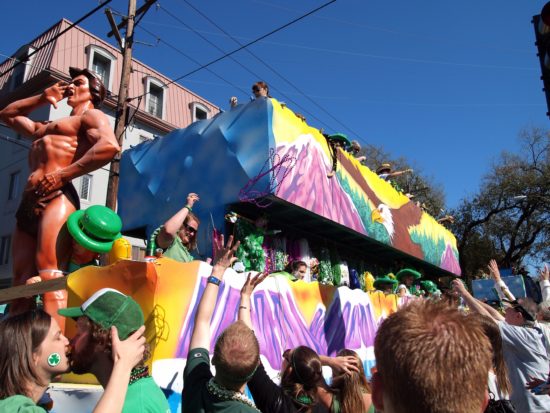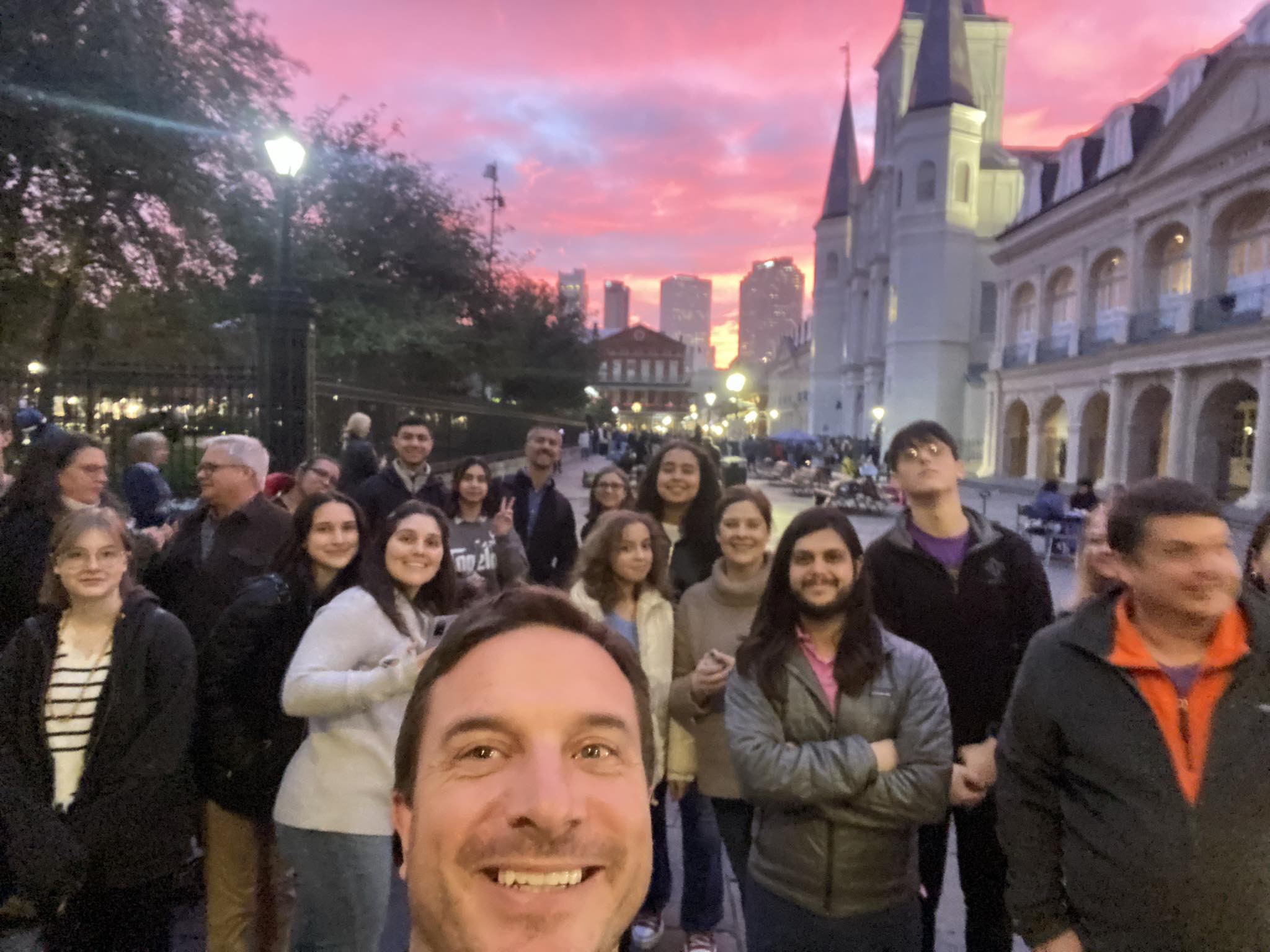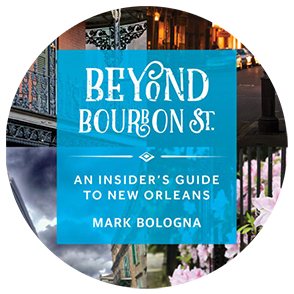St. Patrick’s Day in New Orleans! – Episode #007

St. Patrick’s Day in New Orleans
In this episode we dive into the St. Patrick’s Day celebrations in New Orleans. We cover the parades and block parties, but also explore the history of the Irish in New Orleans and why we celebrate this particular holiday with so much energy. As you’ll discover, the ‘real’ story is the impact of the Irish on New Orleans. Learn about the Irish influence on local government, architecture, banking, the port of New Orleans, the food, and more!
St. Patrick’s celebrations in New Orleans generally span about 10 days, starting the weekend before March 17th and going through the weekend after. The festivities include block parties and multiple parades.
Parades
Jim Monaghan’s French Quarter Parade (Friday before St. Patrick’s Day)
The season traditionally kicks off the Friday evening before St. Patrick’s Day with the annual Jim Monaghan French Quarter parade. The parade begins and ends at Molly’s at the Market in the French Quarter, located on 1107 Decatur Street. Monaghan was a legend in the Quarter where he owned a slew of watering holes, including Molly’s and Erin Rose (listen to episode #6 for coverage of Killer Po-Boys, the popup at Erin Rose).
While Monaghan passed away in 2001, his spirit lives on through his family, the people he worked with in the bars, and the patrons. The parade bearing his name has been around for more than 30 years and is equal parts parade and pub crawl. By the way, this last wife, Liz Scott Monaghan is a bit of a character in her own right. She is an author, and writes under the name Modine Gunch. You can check out her book Never Clean your House During Hurricane Season on Amazon. She also wrote a wonderful summation of Jim’s funeral which you can find on the Erin Rose website.
Irish Channel Parade (Saturday before St. Patrick’s Day)
Just before the parade, a Catholic mass is celebrated at St. Mary’s Assumption Church on Constance St. Following mass the 1,400 member parade starts at 1PM at the corner of Tchoupitoulas and Napoleon right outside Tipitina’s. It heads up Napoleon to Magazine where it turns right and heads downriver. At Jackson Avenue, the parade turns right (towards the river) and goes until it reaches Tchoupitoulas where it disbands. NOTE: the route has changed this year (2016) due to construction. As a result, it does not go down St. Charles Avenue as in past years.
In addition to Mardi Gras style floats carrying riders, the event features hundreds of tuxedo-clad men marching and handing out paper flowers in exchange for a kiss on the cheek from the ladies along the route.
One other note about the parade – in addition to the beads and trinkets common in New Orleans parades, revelers can expect to catch cabbage, carrots, potatoes and other vegetables, too, as well as moon pies! The idea here is to toss the ingredients to a traditional Irish meal. Well, except for the moon pies, but everyone needs dessert, or at least a snack while you’re watching the parade!
St. Patrick’s Metairie Parade (Sunday before St. Patrick’s Day)
This parade, like the one in New Orleans the day before features men in formal wear marching down the street and handing out paper flowers in exchange for a kiss on the cheek. It, too, has riders on Mardi Gras style floats, tossing beads and trinkets, as well as cabbage and other vegetables. Metairie parades are not my favorite – I prefer to be in the city – but this one is an exception because of its location. This parade spends much of its time on Metairie Road, a beautiful, tree-lined street in Old Metairie. Very family oriented, lots of places to eat and something a little different from downtown.
French Quarter Parade (on St. Patrick’s day)
The parade on St. Patrick’s day is presided over by the Downtown Irish Club. Organized in 1976, the parade starts at 6pm in the Bywater at Bud Rip’s bar. The procession goes through the Marigny and into the French Quarter, spending time on Royal and Decatur Streets before disbanding at the corner of Bourbon & Orleans. This parade is part marching club, part home made floats, part 2nd line. The parade itself stops at several bars along the route, making it a sort of combo parade, moving block party and pub crawl.
Block Parties
On both the Saturday before St. Patrick’s Day as well as on St. Patrick’s Day itself, head to the Irish Channel for the block parties. Tracey’s at the corner of Magazine and 3rd street has one end of the affair. A block down 3rd Street at the corner of Constance, you’ll find Parasol’s. Both offer up corned beef and cabbage, green beer, and a host of other drinks and food. Green jello shots are particularly popular! The crowds fill up Constance St with revelers and tend to spill over into the neighboring streets as well. The party starts early in the morning and continues until 8 or 9 in the evening.
Do yourself a favor and don’t try to drive anywhere close to this event. Think about it – you’re likely going there to drink, and you’re headed to an area where most everybody is drinking. This is true on Saturday as well as St. Patrick’s Day, but particularly so when St. Paddy’s day is on a weekday. My thought process here is you have the usual traffic in that area, combined with people sneaking out of work to head over to the party, plus all the people in the street imbibing.
Take the St. Charles streetcar, hop off near Washington Ave and walk the 5 short blocks to Magazine. This is not the greatest area for a walk, but on St. Patrick’s Day and the Saturday before, you won’t be alone! These are also prime events for taking a taxi, Uber or Lfyt.
History of the Irish in New Orleans
We explore this topic in detail during the episode. Listen to it on iTunes or Stitcher. Here’s the highlights…
The first Irish immigrants to come to New Orleans arrived during the Spanish Colonial period. During this time people left Ireland largely because of political reasons, and specifically to avoid English persecution. They generally headed to France or Spain to escape English domination, and to practice their Catholic faith. In many instances they pursued one of two paths – they joined the military of Spain or France, or they were merchants or businessmen.
For similar reasons, some of these Irish citizens were attracted to New Orleans. Here, they found a Catholic community, and a shared dislike of the English. Additionally, there were plenty of opportunities in the New World.
In general, the immigrants who made it to New Orleans during this time were most often middle class and not poor, given the high cost of passage. This group also integrated fairly easily into New Orleans society. Immigrants were doctors, lawyers, bankers, printers and journalists. They frequently married into existing families here and did not have an ethnic enclave of their own.
In the early to mid 1800s (1810-1850) a second, much larger wave of Irish immigrants came to New Orleans. Looking to escape the famine in their homeland, many found passage on the cotton ships. These ships left from New Orleans and traveled to Liverpool where they dropped off their bales of cotton. In need of ballast for the return voyage, they were often filled with immigrants, many of Irish background looking for an inexpensive though not pleasant transport back to the New World.
New Orleans was attractive for several reasons. For one, it was (and largely still is) a Catholic city. Additionally, in the 1800s New Orleans offered a wealth of job opportunities. While many were centered around the port, New Orleans was a commercial center. The Mississippi River offered another attraction beyond the transport of goods. It was a relatively easy means of travel into the interior of the country or the reverse. Compared to places like New York and Boston this was a competitive advantage enjoyed by New Orleans.
This wave of immigration also coincided with the rise of cotton as a major commodity, and the appearance of river traffic on the mighty Mississippi. To put this in context, the 1st steamboat arrived in New Orleans in 1812 – it was, in fact, called the New Orleans. It was the beginning of a new era of prosperity in the city. In the 1810s there were about 20 boats plying the trade waters of the river. By the 1830s there were 1200 and by the 1850s – 30,000! By this time, New Orleans was the 2nd largest port in the United States and the 4th largest (busiest) in the world.
New Orleans, at this time, had the largest population of Irish immigrants in the American South. In fact, by 1850 one in five New Orleanians were from Ireland. While we often think of New Orleans as a French and Spanish city, in the mid 1800s the Irish could certainly claim it as theirs!
Resources & Credits
A lot of the research for this episode came from Laura Kelley’s wonderful book , the Irish in New Orleans. Dr. Kelley’s work is comprehensive and engaging. If you want a deep dive into the history of the Irish in New Orleans, I encourage you to check it out. If you’re out of town, grab a copy online at Amazon, but if you’re in New Orleans head over to Octavia Books or the Maple Street Book Shop and pick up a copy in person.
If you ever want to go down the rabbit hole on 19th century New Orleans take a look at the Robinson Atlas. The Robinson Atlas was published in 1883, but contains a series of thirty maps most likely put together in the 1870s. The level of detail and the insights into the city are fascinating. For instance, one thing that is revealed through the atlas are the number of lumber yards along the New Basin Canal. This is instructive because out by the lake was a large grove of Louisiana bald Cypress. The cypress harvested along the canal was used to build many of the Garden District and Uptown homes you see today.
Thanks so much for listening to this episode! If you want to hear more shows like this one, please subscribe on iTunes or Stitcher. New episodes are available every other Wednesday.
Until next time, laissez le bon temps rouler!
RELATED PODCASTS

The Essential Guide to New Orleans Jazz Fest
The Essential Guide to New Orleans Jazz Fest Ever been to Jazz Fest, or want to go? We’ve got all the insider tips you need to have ..
Haunted New Orleans
Haunted New Orleans Interested in haunted New Orleans? Ghost stories, and other popular and untold legends? This is the episode for you! Join me and guest Orion ..
Robert LeBlanc, Local Entrepreneur
Róbert LeBlanc One of the things I really like to do with the podcast is highlight businesses I think you would enjoy that also have owners who ..BUY THE BOOK, T-SHIRT & HAT









